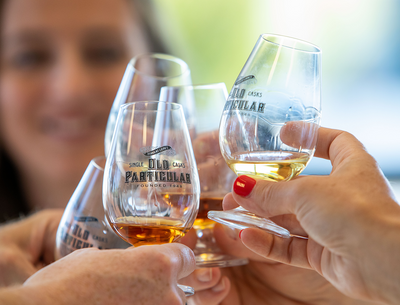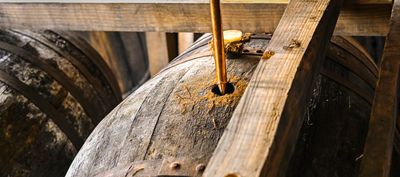Our Fellow, Dr. Heinz Weinberger, from Germany, is a scientist and a passionate Whisky lover. He writes his own blog – Whisky-Connaisseur.de– but he also guest blogs for us, and this one delves into the chemical background of the formation of vanilla flavouring in Whisky....
MANY WHISKIES HAVE A MORE OR LESS PRONOUNCED VANILLA AROMA, EACH GIVING THE SPIRIT A PLEASANT AND CAPTIVATING SMELL
Many Whiskies have a more or less pronounced vanilla aroma, each giving the spirit a pleasant and captivating smell. It is therefore not surprising that the spice vanilla – and in particular its main aroma substance vanillin – is said to have various positive effects, such as an aphrodisiac effect. In addition, vanilla is said to brighten the mood and therefore have a positive effect on anxiety or depression. The vanilla aroma in Whisky is really very nice. When I had Douglas Laing's 30 Years Old Benrinnes from their XOP range in the glass, a pleasant and sweet scent of vanilla instantly streamed into my nose. It increased to vanilla custard on the palate. The same goes for their 18 Year Old Rock Oyster. A well put together, rich and lively limited edition Blended Malt embracing the character of Orkney, Arran, Jura and Islay. A strong, peppery and smoky dram with a sweet and creamy core of vanilla. But how does this miraculous substance vanilla get into the Whisky?
THE SCIENCE OF VANILLA AND WHISKY
The spice vanilla comes from Central America and Mexico, but is nowadays mainly grown on Madagascar and the neighbouring island of Réunion (formerly Íle Bourbon). Hence the name Bourbon vanilla. Vanilla, known as the queen of spices, belongs to the orchid family, from whose fermented capsules the organic compound vanillin is extracted. Vanillin is already noticeable in extremely low concentrations, although the odour does not noticeably increase – regardless of the increasing concentration of vanillin. The threshold value for sensory perception of vanillin in pure water is 2 mg/L. Alcohol increases the sense of smell and taste of vanillin, so that the threshold value in a 40% alcohol solution (as it is in Whisky) is already about ten times lower at 0.1 mg/L. Accordingly, we perceive the scent and flavour of vanilla in Whisky rather than in pure water. In pure form, vanillin (chemical name: 4-hydroxy-3-methoxybenzaldehyde) forms colourless to slightly yellowish needles, which unfold their characteristic scent of vanilla. Chemically speaking, this aromatic compound is a derivative of benzaldehyde, which has a marzipan-like smell. Interestingly, the typical vanilla smell is strongly dependent on the chemical structure. The vanilla aroma of the structurally similar compound isovanillin (chemical name: 3-hydroxy-4-methoxybenzaldehyde) is hardly noticeable in the same quantities.

During the production of Whisky, vanillin is obtained in two different ways. On the one hand, it occurs during fermentation. This is the production step in which the sugar-containing wort is converted into an alcoholic solution when yeast was added. Secondly, vanillin is obtained during maturation of Whisky in oak barrels. This is by far the more common method of vanilla generation. The main constituents of wood in general are cellulose, hemicellulose and lignin, with the cellulose having the largest proportion with 40% to 55%. Hemicellulose and lignin are distributed approximately evenly (approx. 20% to 30%). Cellulose is a linear, unbranched, long-chain macromolecule consisting of at least 10,000 identical sugar building blocks, namely glucose. Hemicellulose, on the other hand, is not a long-chain macromolecule, but is characterized by much shorter chains (approx. up to 220 sugar units) and branches of various sugar molecules and serves as a scaffolding substance for the cell walls in plant cells. The third main component of wood, lignin, is the most common organic, non-carbohydrate-containing material on earth. It consists of a group of "polyphenols", which are composed of various aromatic building blocks to form a complex, high-molecular, three-dimensional network. All these three wood components are per se odourless and tasteless.
Vanillin is extracted from the oak wood during oak barrel maturation. The lignin in the oak is oxidized when it gets into contact with ethanol (drinking alcohol) of the fresh distillate and in presence of oxygen, forming aromatic compounds, so-called aldehydes, of which vanillin is one. The amount of vanillin produced depends on the type of oak wood used, with American white oak (quercus alba), compared to European oak species (e.g. quercus robur and quercus petraea), usually producing a smaller amount of vanillin. But how can this explain the strong vanilla flavour in bourbon Whiskey, which matures exclusively in American white oak barrels? The answer can be found in the so-called charring process – a method where flames are fired into barrels to char them before filling. This results in a millimetre-thick layer of charcoal forming inside the barrel, which acts as an activated carbon filter and removes the unwanted aromas and flavours – such as volatile organic sulphur compounds – from the new make spirit. These molecules make themselves unpleasantly noticeable even in the smallest concentration due to their characteristic smell of cooked vegetables, cabbage, asparagus, lit matches and even rotten eggs.
On the other hand, heat treatment triggers chemical reactions in the wood, in which lignin can now be thermally converted into aromatic substances via three different degradation routes. The degradation pathway of interest to us runs through an aromatic acid, the so-called ferulic acid, which is further converted to vanillin and, by subsequent oxidation, to vanillic acid. This thermally-induced structural change and degradation reaction takes place in wood up to a depth of 6 millimeters. Due to opening and cracking of wood as a result of thermal stress, these aromas can be removed by the maturing distillate and can thus be transferred to the matured Whisky. Chemical analyses of Whisky in new, toasted oak barrels have shown that vanillin exceeds its sensory threshold within the first 6 months of oak barrel maturation and is therefore noticeable in the smell and taste after this short period of time. According to experts, about 60% to 80% of the taste components in the finished Whisky are derived from barrel maturation and especially from the oak wood used. Barrel ageing increases the complexity of the Whisky, giving it colour, texture, fragrance, fineness, maturity and many other generally pleasant aromas.





